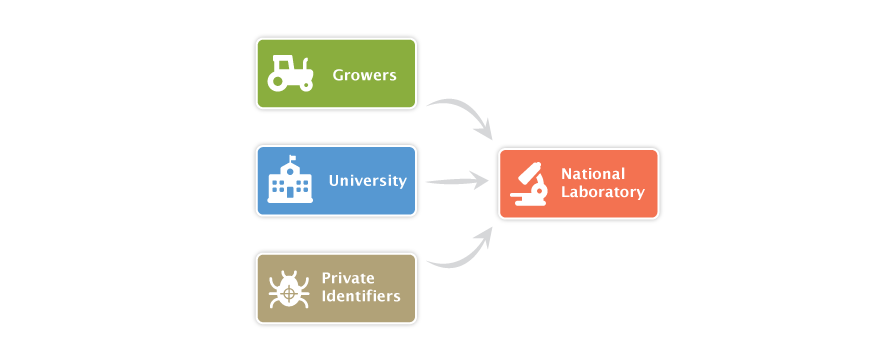Lesson 1: Framework for Timely Official Pest Identification
Topic 1: Pest Identification Framework
A framework provides clear organization for a country’s pest identification network. Knowing where samples should be sent and who will complete the identification saves time and gives trading partners confidence in the process.
Objective:
- To identify which laboratory has official authority to make final decisions about pest identifications.
The National Plant Protection Organization (NPPO) of each signatory country is responsible for the plant welfare of their country. Protecting plants from pests and disease is complex and involves many tasks and responsibilities. Under the International Plant Protection Convention (IPPC), the NPPO of each signatory country has these responsibilities:

- Issue certificates related to phytosanitary regulations
- Survey for pests
- Inspect plants and plant products in trade
- Disinfest regulated articles to meet phytosanitary requirements
- Protect plants within its country from pests
- Conduct pest risk analyses (PRA)
- Train and develop staff to carry out these responsibilities
For an NPPO to be effective in all of these tasks, it must have access to an efficient, reliable, and official system for identifying potential pests. There are many different identification frameworks for creating an official pest identification system, and every country uses the framework that works best for its circumstances. It is up to the NPPO to determine what the identification framework for its country will be. It is also the responsibility of the NPPO to take action, based on pest identification, to protect products in trade, as well as plants within its country. This action should be based on reliable identifications from a laboratory authorized to issue final identifications.
In some countries, there may be just one central laboratory with identification authority. In other countries, there may be many laboratories that perform identifications. In some of those countries, regional or local laboratories may be given authority by the national laboratory to identify specific pests. If so, these laboratories usually go through a certification process. In other cases, the regional or local laboratories may always send samples to a central laboratory before regulatory action happens. It all depends on a country’s circumstances and needs.
As you will see in the two examples that follow, all countries have a designated, central authorized laboratory to make final identifications. Remember, these are just example frameworks, and each country has slightly different variations of these examples. Each country’s circumstances will dictate the most practical pathway for everyone to follow so that all samples are sent to an authorized laboratory as efficiently as possible. Hover your cursor over individual boxes for examples of the different groups involved in plant protection.
Simple Pest Identification Framework (most countries)

Grower
Farmer producing a plant commodity (orchards, fields, vineyards).
University
School of higher learning with expert researchers in relevant plant pest fields.
Private Identifiers
Pest control companies and other professional pest consultants.
National Laboratory
Laboratory with the authority to make final identifications. For many countries, this is one centralized laboratory.
Complex Pest Identification Framework (United States, Australia)

Grower
Farmer producing a plant commodity (orchards, fields, vineyards).
University
School of higher learning with expert researchers in relevant plant pest fields.
Private Identifiers
Pest control companies and other professional pest consultants.
Surveillance Officer (USDA Officers)
Someone with national authority to conduct pest surveillance. In the United States, it could be a USDA officer. In other countries, it could be a local, state, or provincial plant health official.
State Laboratory
For countries divided into smaller regions, such as provinces, districts, or states, each region may have its own diagnostic laboratory. These regional laboratories report to the appropriate national laboratory unless authorized by the national laboratory to make final identifications.
National Laboratory
Laboratory with the authority to make final identifications. Countries using a complex framework, such as the United States, usually have several authorized laboratories. The laboratories specialize in different types of pests or plant pathogens.
The NPPO should communicate clearly with all laboratories in its country so that everyone knows exactly where to send suspicious samples for final identification. It is essential for the NPPO to make clear that the central authorized laboratory must make final identifications before any regulatory action is taken to protect the country. When the NPPO clearly communicates where to send samples and who has authority to identify pests, it ensures that laboratories can easily trace pest identification decisions. It can also demonstrate that a legal authority made the identifications that guided regulatory action.
To continue, select Lesson 2 from the Lessons menu above or click here.